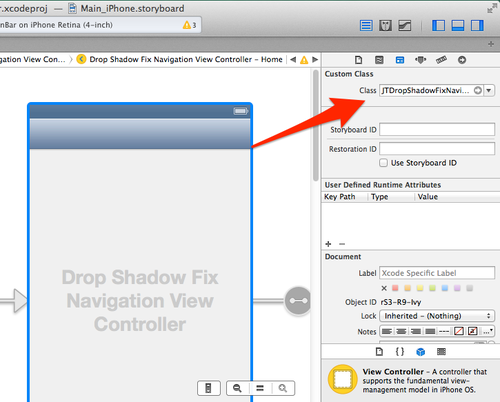Created by Jamz Tang at 17 September 2013
Using custom drop shadows in UINavigationBar (fix for iOS 6.1)
This is an update to the Adding Drop Shadow on UINavigationBar which was written prior to iOS 6.0
Since iOS 6.0 Apple introduced the -[UINavigationBar shadowImage] property. We should probably leverage that, which are also UIAppearance selectors.
// Configure your images
UIImage *background = [UIImage imageNamed:@"titlebar44"];
UIImage *shadow = [UIImage imageNamed:@"titlebar-bottom-highlight"];
// Using the appearance proxy
// Note: setBackgroundImage:forBarMetrics has been documented to be
// **compulsory** to enable the displaying of the custom shadow image.
[[UINavigationBar appearance] setBackgroundImage:background forBarMetrics:UIBarMetricsDefault];
[[UINavigationBar appearance] setShadowImage:shadow];
You probably went with similar code, but the custom shadow just didn't show up, right?
The problem occurs because of the implementation on UINavigationBar, the clipsToBounds property is needed to be set to NO, and this step has been missing from the documentation. (At least I didn't find it)
Most probably you'll need to set self.navigationController.navigationBar.clipsToBounds = NO in every UIViewController subclass you wrote, a more convenience way is to subclass UINavigationController and have it do the job for you. And I've created a snippet for you.
/*
* This file is part of the http://ioscodesnippet.com
* (c) Jamz Tang <jamz@jamztang.com>
*
* For the full copyright and license information, please view the LICENSE
* file that was distributed with this source code.
*/
#import <UIKit/UIKit.h>
@interface JTDropShadowFixNavigationViewController : UINavigationController
@end
/*
* This file is part of the http://ioscodesnippet.com
* (c) Jamz Tang <jamz@jamztang.com>
*
* For the full copyright and license information, please view the LICENSE
* file that was distributed with this source code.
*/
#import "JTDropShadowFixNavigationViewController.h"
@implementation JTDropShadowFixNavigationViewController
- (void)viewDidLoad {
[super viewDidLoad];
self.navigationBar.clipsToBounds = NO;
}
@end
#if ENABLE_JTDROPSHADOW_GLOBAL_FIX
@interface UINavigationBar (JTDropShadowFix)
@end
@implementation UINavigationBar (JTDropShadowFix)
- (void)awakeFromNib {
self.clipsToBounds = NO;
}
@end
#endif
So now you can initialise your view controllers in code like this:
UIViewController *controller; // configure your view controller
UINavigationController *navController = [[JTDropShadowFixNavigationViewController alloc] initWithRootViewController:controller];
Or if you use storyboard, simply change the subclass of your UINavigationController to JTDropShadowFixNavigationViewController.

In fact there's an even simpler method you'll notice in the snippet.
This is a hack that adds a category method to always set clipsToBounds to NO for UINavigationBar. Enable it defining this constant somewhere in your code (recommended in .pch):
#define ENABLE_JTDROPSHADOW_GLOBAL_FIX 1
Let me know your thoughts!
Installation
Using CocoaPods: [?]
pod 'JTDropShadowFixNavigationViewController', '~> 0.0.1'
Clone this repository:
git clone git://gist.github.com/6591926.git JTDropShadowFixNavigationViewController
If you think this is useful, share this article with your friends :)
blog comments powered by Disqusioscodesnippet.com
UINibDecoderProxy Observes what's encoded in an NSCoder object
Observes what's encoded in an NSCoder object
JTKeyValueObserver Revisiting KVO+Block, the simplest version.
Revisiting KVO+Block, the simplest version.
MethodSwizzle Method Swizzling in Objective-C
Method Swizzling in Objective-C
UITableViewDeleteActionResponder Quick hack to enable delete menu item in UITableView menuController
UIApplicationAddition Quickly switch supported UIInterfaceOrientation for your View Controllers
JTTargetActionBlock Adding Block support for UIControl's Target-Action mechanism
Adding Block support for UIControl's Target-Action mechanism
NSArray-JTArraySplit Splitting an array to several components
UIImage+JTImageDecode Force decompressing UIImage in background to achieve better performance
UINavigationBar-JTDropShadow Adding drop shadow on UINavigationBar (before iOS 6)
UIImage-JTImageCrop Crop an image in specific rect
UIView+JTRemoveAnimated Adding fadeout effect to any -[UIViews removeFromSuperview]
JTStringAddition NSStringf. Simpler printf styled +[NSString stringWithFormat:]
UIView-JTViewToImage Rendering any UIViews into UIImage in one line (updated with iOS 7 support)
Rendering any UIViews into UIImage in one line (updated with iOS 7 support)
NSObject-JTNibLoader Loading a Nib file programmatically using NSObject category
Loading a Nib file programmatically using NSObject category
UIImage-JTColor Creating a placeholder UIImage dynamically with color
Creating a placeholder UIImage dynamically with color
NSObject-JTCancelableScheduledBlock Cancelable Scheduled Blocks in Objective-C
Cancelable Scheduled Blocks in Objective-C